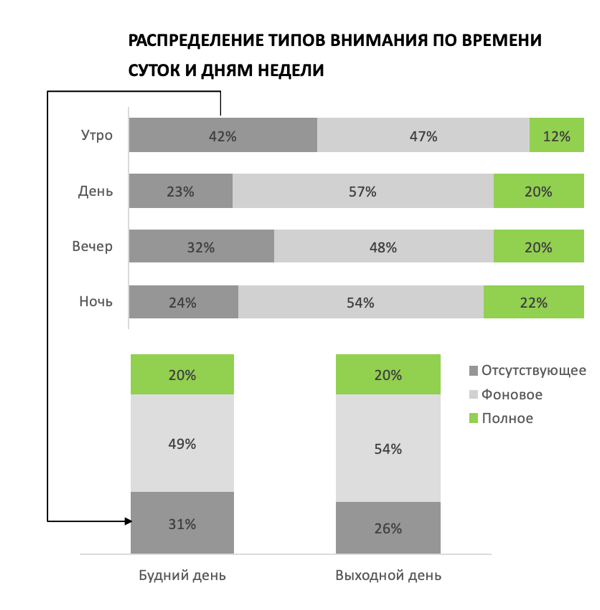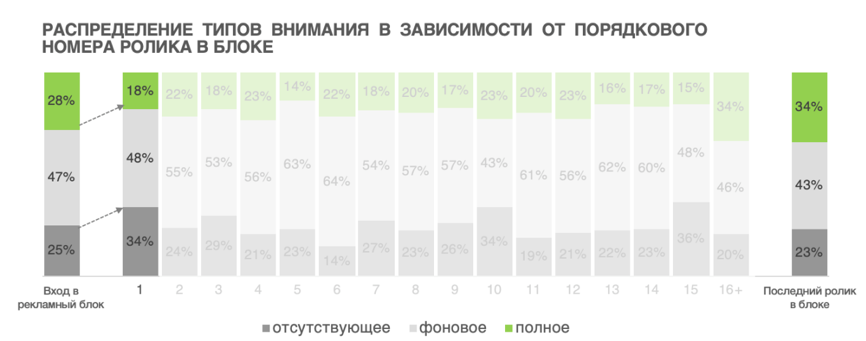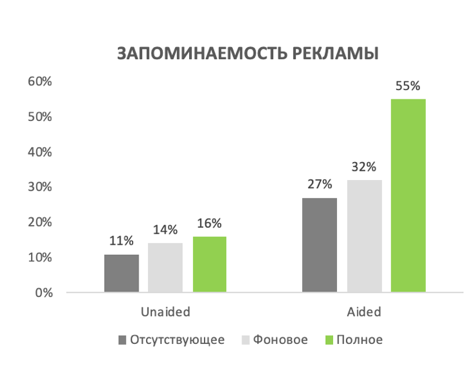We in the advertising group Dentsu Aegis Network decided to study a radically new approach to assessing the effectiveness of advertising, focusing precisely on attention as a metric that most broadly reflects the human perception of advertising.

As part of the Attention Economy Russia project, we took the first step towards a new media currency and, together with the Synopsis Group, conducted a pilot study of audience attention to advertising on different platforms. In the first part, it was devoted to television, which will be discussed in this article. In the next one, we will talk about measuring attention in digital (on desktop and mobile).
How it all began
For a session of 40 minutes on a smartphone, a person consumes up to 200 advertising messages of various types, and this is only one screen. Huge information flow and advertising clutter leads to low focus, background and even lack of attention to information.
Let's project a situation: a young mother is watching TV while she is doing her household chores, and the child is sleeping. Such background watching. In the current paradigm of viewing TV viewing, “TV on” means that the content was watched. And in fact:
- How many minutes did you actually look at the screen?
- What was the spectator distracted by - a mobile phone, cooking porridge, work?
- What if a child woke up in another room and the TV was still on?
The questions are not just rhetorical, but require research and understanding of the importance of attention, its impact on the key performance indicators of advertising on different platforms of its placement.
Taking into account the context, coverage has long seemed to be insufficient KPIs, which is why such indicators as searches or viewability (the visibility of an advertising message) began to appear in advertising. Now, planning KPI in digital can be targeted, high-quality and viewable coverage, but on TV it is almost impossible due to the complexity of monitoring.
We have long looked towards the attention economy in relation to media and advertising, but we were inspired by a global study to take concrete steps in this direction.attention that our group started in 2019 in Australia, UK and USA. Thus, it was decided to conduct a local laboratory wave of research in order to test hypotheses related to attention on key screens in Russia.
As part of the pilot, it was important for us to answer the following questions:
- What technologies will help us assess the attention to advertising on different media?
- What types of attention to advertising are there?
- Is there a relationship between attention and efficiency?
- Could attention impact the industry in terms of building a new ad sales model based on contact quality based on the level of attention at the time the ad is viewed?
Since the task is very ambitious, an ongoing process is needed: start with proving that attention is really an important indicator for assessing the effectiveness of advertising, test the technology, and already at the second stage, conduct a large-scale qualitative research and collect quantitative results to form a metric.
Next, we will tell you how we managed to make reconnaissance in force - to test the methodology and technology, to collect hypotheses and observations for the quantitative stage. The pilot study consisted of two parts, in the first part, supported by a single TV ad vendor, NRA, we focused on assessing the level of attention to TV ads. See what happened.
How the study was conducted
We have formed two key hypotheses:
- , , .
- , .
To test the hypotheses, we settled on Moscow and carried out measurements among the most demanded audience of 25-44 among advertisers. The recruiting of the “average Muscovite” was done according to the audience profile of the Mediascope research panel (the largest media meter in Russia) - social demographic parameters and characteristics of media consumption. This was necessary for further interpretation of the results in relation to the generally accepted indicators in the media market.
The study identified three types of attention: full (direct eye contact with the TV screen when the sound is on), background (peripheral contact with the sound on and minor distractions such as using a smartphone), and absent (absence of a person in front of the TV screen, for example, when he left the room).
The key parameter for evaluating the effectiveness was the ad recall. In the course of our research, we decided to test how attention to an advertising message is converted into memorization (with and without a hint).
Obviously, in order to determine the level of attention to television content, it is very important to measure at home, or in natural conditions, so that respondents have the opportunity to be truly distracted by what occurs in their daily routine - cooking, communicating with other family members, and etc.
For this we installed two cameras in the room with the main TV. One wide-angle camera directly in front of the TV monitored the dynamics of the respondent's attention while watching and switching to other actions. The second camera was a kind of analogue of a people meter, which is widely used in measuring TV audience, and was aimed at the TV to record the broadcast. This made it possible to subsequently synchronize with Mediascope data and separate advertising from the main broadcast content.
As part of the test, we tried to select those commercials that just started on the air and did not have time to become familiar to the respondents. The cameras were in the respondents' apartment for several days, so we managed to record 24 hours of viewing both on weekdays and on weekends. At the end of the day, respondents took a survey in which they noted the advertisements that they had seen on TV over the past day.
results
The key takeaway from both the global and local research pilot is that users watch ads primarily in the background. About half of all viewing situations are characterized by background attention. In particular, less than a quarter of views on TV receive full attention.
The main disruptor of attention while watching TV is the smartphone (40% of switching from full to background attention). At the same time, switching from an intense type of attention to a passive one is often associated with personal factors: in 2/3 of cases, respondents are not distracted by anything from watching TV, they themselves start watching content less involved.
There is a difference in engagement rates depending on the days of the week and the intervals during the day. In the morning hours, there is a lower proportion of total attention in favor of the absent person: respondents leave the TV on during the morning routine, moving around the apartment and being distracted by their usual activities, such as making breakfast.
A high proportion of lack of attention in the morning negatively affects the proportion of lack of attention on weekdays, while the proportion of total attention on weekdays and weekends does not differ.

The results on the dynamics of attention within the ad unit turned out to be interesting. The first, and the subsequent transition from one type of attention to another, occurs on average at 27 seconds. During the first three switchings of attention, its intensity slightly decreases, and towards the end of the ad unit it begins to grow.
When moving from the main broadcast content to the ad unit, the share of full attention is 28%, sharply falling to 18% in the first video. Towards the end of the ad block, the full attention rate begins to rise on average three commercials before the on-air content resumes. The last video has 34% full attention.
Decreased engagement is associated with a lack of focus. The respondents get tired of watching even interesting and deliberately selected TV content without interruption. Some of them switch to other parallel actions, so attention decreases even before the start of the ad unit. At the same time, respondents do not want to miss the start of the continuation of the main broadcast and return their attention to the screen several videos before the end of the ad block.
For example, you are watching a TV show. The action, as often happens, dragged on, and you were distracted by household chores. Suddenly you hear that there is an unexpected plot twist, and, of course, advertising immediately begins. In order not to miss the sequel, after a certain period of time (during which, as you think, the ad block should last), you sit down in front of the TV with readiness to watch the ad.

Another important observation is related to the information clutter. We saw that the shorter the ad at the beginning of the block, the faster the intensity of attention decreases. So, if the average duration of commercials is 10 seconds or less, then attention will be switched at 15-20 seconds (on average, 2-3 videos per block will be watched). If the average duration of the first clips in a block is more than 15 seconds, then attention will be switched at 60 seconds and beyond.
When assessing engagement in TV advertising, the impact of sound should not be underestimated. The soundtrack approximately doubles the recognition of the video.
Most importantly, as a result of the study, we found a direct relationship between the intensity of attention to advertising and the level of its memorability: the more intense the attention, the higher the recognition. This is also true for recognizability with or without a hint.
Full attention is almost twice as effective as viewing with background intensity to recognize a prompted video. We tested new commercials and it is rather difficult to recall them without prompting without reaching the required frequency, but the frames of those videos that were watched with full attention are easier to remember.

What's next
Many conclusions seem logical and understandable, but most of them were measured and digitized for the first time on the market. The pilot TV study helped us believe that we are on the right track. Attention is a significant factor that affects the effectiveness of an advertising contact.
Moreover, we understand that it is really important to conduct research at home using cameras that record the direction of gaze and the presence of sound when viewing in the background, in order to determine a wide pool of distractions and their impact on the perception of television broadcast.
We plan to scale up the study in the second wave, during which we will try to cope with the artifacts of the pilot stage, stabilize a sample that is representative of the whole country, understand the significance of the content surrounding the ad, the frequency of ad impressions, and also evaluate not only direct, but also sponsored advertising.
And the most important ambition for us is the formation of a new currency of the advertising industry - qCPP, where “ku” is an indicator of attention.